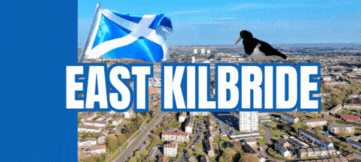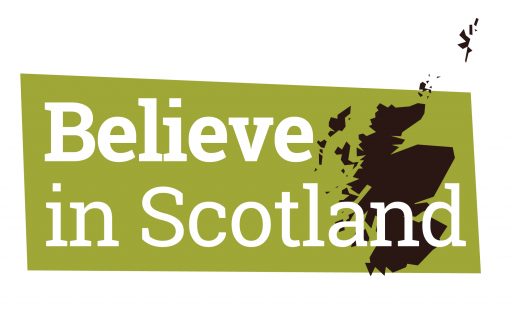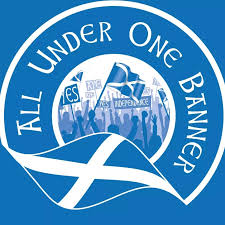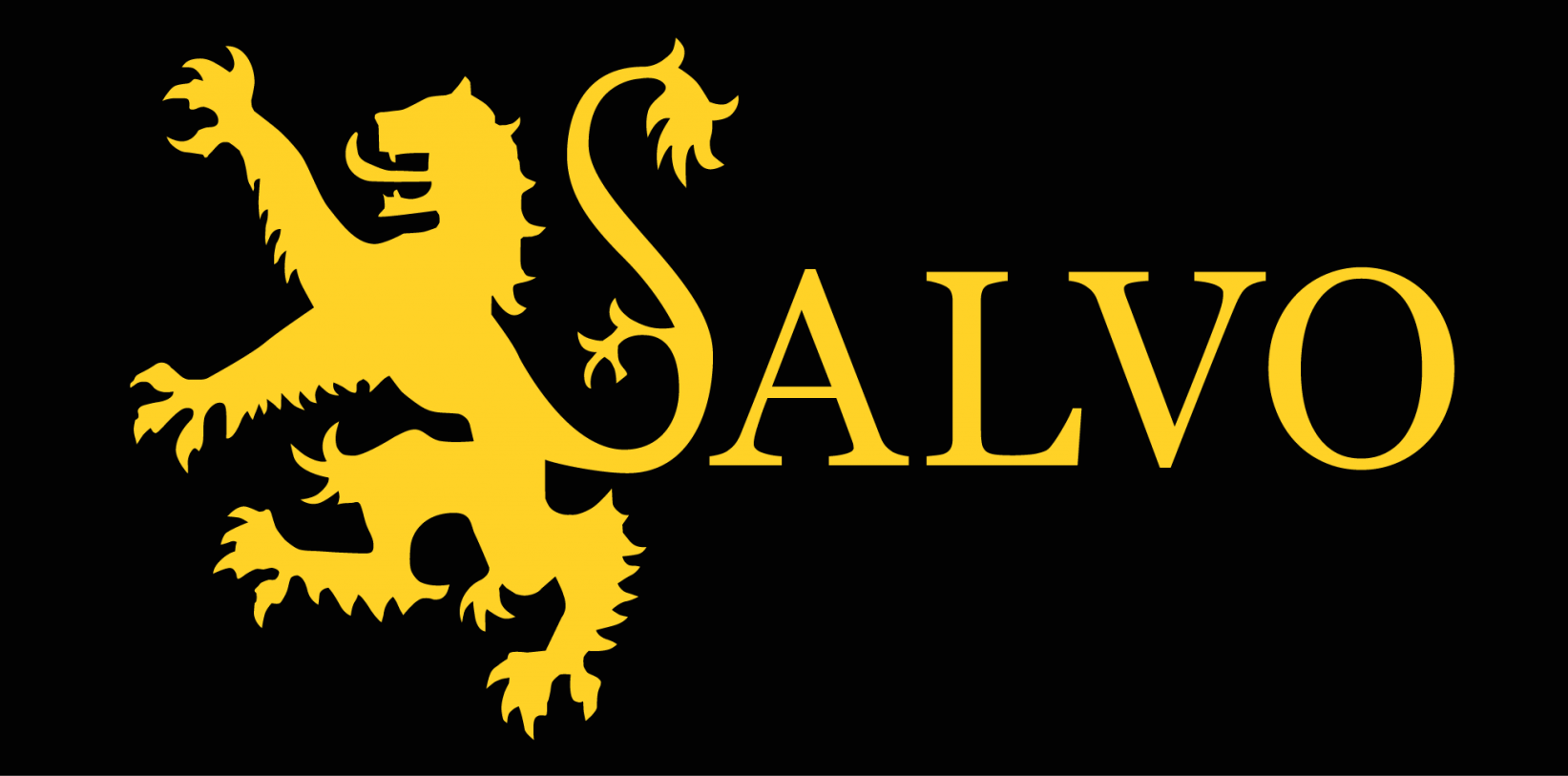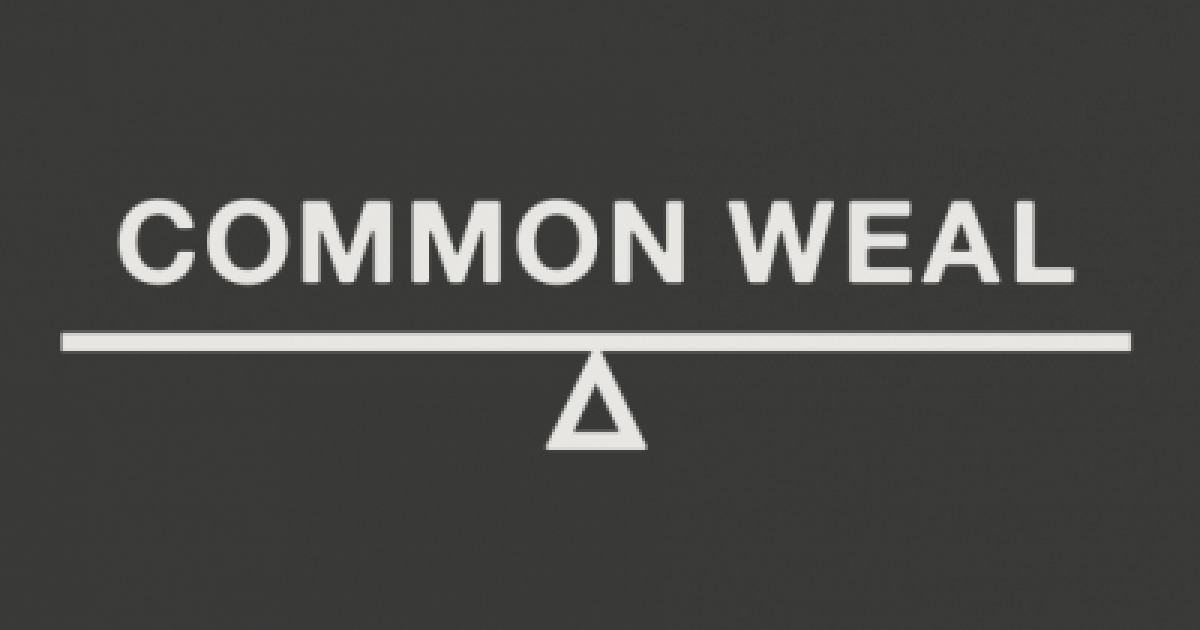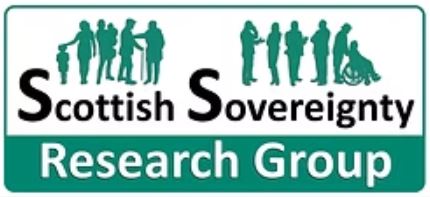
 Located at 197 meters (646 feet) above sea level, on high ground to the south of Cathkin Braes, 8 miles (13km) southeast of the City of Glasgow, East Kilbride was the first and most successful of the Scottish new towns born of the New Towns Act of 1946. However the town’s origins significantly pre-date the new town development, with the earliest known evidence of occupation dating back to the late Neolithic and early Bronze Ages. With multiple burial cairns and other significant artefacts discovered at Law Knowe and other sites across the town, including a flint arrowhead from 1500 BC, which made the headlines after being discovered by a very young Allan Forrest in 1970 in the family garden in the St Leonards area of the town. The oldest parochial register of the parish is dated on the 28th March 1688, with the first register of a marriage dated on the 28th of the same month, and the first birth shortly after on the 1st of April. It should also be noted that the lands of Busby were formerly part of the parish of Kilbride but were annexed to Carmunnock in 1642, and again in 1725 ‘quoad sacra’ (for religious reasons). Thus by 1883 the parish contained the villages of Auldhouse, Kittochside, Nerston, Maxwelton and “comprises the ancient parishes of East Kilbride and Torrance”.
Located at 197 meters (646 feet) above sea level, on high ground to the south of Cathkin Braes, 8 miles (13km) southeast of the City of Glasgow, East Kilbride was the first and most successful of the Scottish new towns born of the New Towns Act of 1946. However the town’s origins significantly pre-date the new town development, with the earliest known evidence of occupation dating back to the late Neolithic and early Bronze Ages. With multiple burial cairns and other significant artefacts discovered at Law Knowe and other sites across the town, including a flint arrowhead from 1500 BC, which made the headlines after being discovered by a very young Allan Forrest in 1970 in the family garden in the St Leonards area of the town. The oldest parochial register of the parish is dated on the 28th March 1688, with the first register of a marriage dated on the 28th of the same month, and the first birth shortly after on the 1st of April. It should also be noted that the lands of Busby were formerly part of the parish of Kilbride but were annexed to Carmunnock in 1642, and again in 1725 ‘quoad sacra’ (for religious reasons). Thus by 1883 the parish contained the villages of Auldhouse, Kittochside, Nerston, Maxwelton and “comprises the ancient parishes of East Kilbride and Torrance”.
It was in the St Leonards area, formerly known as ‘Torrance’ itself originally separate from the Kilbride Parish until 1589, in which stood an ancient chapel and hospital close to the current Newhousemill Bridge (The Wee Bridge). It is not clear when these were originally built, but were certainly pre-13th century. The Torrance Chapel and hospital were dedicated to St Leonard, a fifth century French Hermit. It is thought to be resulting of the direct influence of the Norman Knight Roger de Valoins (Valoniis) who acquired the lands of Kilbride in the 12th century. The buildings were in ruin by 1589 and were totally demolished in the 18th century. The accompanying chapel graveyard site, better known today as the East Kilbride streets of Tiree, Coll, and Mull. It is understood that the remains were cleared from the site many years ago and utilised as a fertiliser in neighbouring farmsteads. In addition there have also been a number of Roman discoveries in the town, suggesting civil and military activity including settlements, and forts in sync with the area being present on the core travel routes from antiquity. Artefacts such as coins have been discovered in and around the town area and even the rumour of a Roman Road discovered during the upgrade works of the Motorola site in the early 1990s.
The earliest known documented mention of the area dates back to the 12th century during the reign of William the Lion, when religious records mention the church within the village (originally known as Kirkton of Kilbride, and later Kirktonholm) operating under the control of the Bishops of Glasgow at that time. The current church built by James Pollock 1774-75 still stands proud within the heart of the village area, now known as the East Kilbride Old Parish Church. Archaeology of the Church site and respective lands has returned evidence to support the belief that the current Church sits upon an earlier site used for worship in the pre-Christian period.
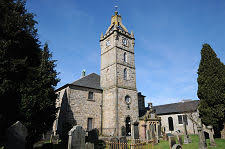
East Kilbride Old Parish Church
The town originally known as Kilbryde (Cille Bhrighde an Ear) in which the last syllable of the word Kilbride is a contraction for Bridget or Brighid, the Gaelic name for the famous saint. With the formative syllable ‘Kil’ coming from ‘Cil’ a Gaelic word for a church or burying place. Thus the name translates to the Church, or burying place of St Bridget or Bride. Although the specific Saint Bride is still up for discussion. Historians still debate if the name is in reference to the Irish saint from Kildare, or the Scottish St Bryde born in 451 AD. There is even the possibility that the name comes from the Celtic Goddess Brigid, who it is suggested is associated with pre-Christian worship in the area.
In the 18th century the town was renamed with the addition of the ‘East’ in order that it could be distinguished between the Ayrshire town of ‘West Kilbride’ following the addition of a Post Office in the respective towns.
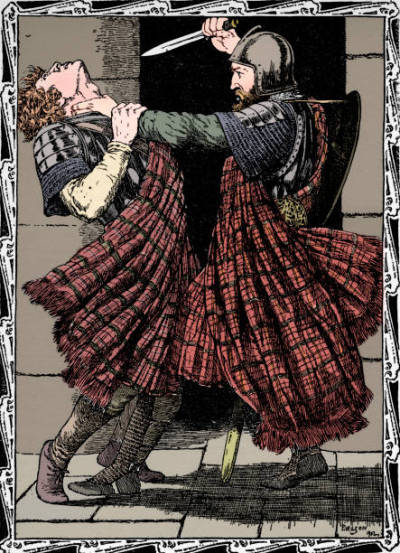
Comyn stabbed by Bruce at Grefriars Kirk in Dumfries.
The lands of Kilbride have traversed through a number of notable and powerful families from Scotland’s history including the Maxwell’s of Calderwood, and the Stuarts of Torrance who have ‘frequently given to the nation, men of distinguished ability, who have honourably supported leading characters in the camp or the court’. But before their time there were of course the Comyns. The most famous of which being John ‘the Red’ Comyn. John Comyn sprung to prominence initially an ally and supporter of William Wallace during the Wars of Scottish Independence, although contemporaries have described the relationship between both parties during this period as ‘complex’. John himself was later ‘dispatched’ following a meeting with Robert Bruce at Greyfriars Kirk in Dumfries on the 10th February 1306. This brought to an end a long standing dispute between Bruce and Comyn regarding the future direction of the Scottish crown, and saw Robert Bruce banished from the church for his efforts. Ironically the lands which were fortified with the construction of Kilbride or Comyn Castle during their fights against the future King were confiscated by Bruce and later given as a dowry for the wedding between his daughter Marjorie (Countess of Carrick) and Walter the Steward in 1315. The marriage which in fact established the beginnings of the powerful Stuart Dynasty. Walter the Steward (Robert II of Scotland) would later pass the lands over to John Lindsay of Dunrod from Renfrewshire for his ‘good and faithful services’ during the wars of Independence. The Lindsay’s relocated their family seat from Inverkip to Kilbride, and constructed their own fortification in Mains Castle just south of the ‘Comyn’s Castle’ (Laigh Mains motte) and made it their main seat for circa 150 years. This remained the family seat until the much of the estates were sold in 1619 for a ‘paltry sum’ to address the debts of the ‘Wicked’ Alexander Lindsay of Dunrod. Named as such to distinguish him from previous generations who were of ‘better character’. His downfall in fortune was said to be heavenly vengeance for his overall brutality to many, including those under his employment, and specifically the earlier murder of the ‘great hero’ Alexander Leckie of the Cunningham family. Leckie was murdered by Alexander from a single gunshot being fired out of a farmhouse window at Hagton Hill near Glasgow following a long-standing feud between the families.
Other than Mains Castle, the town has been resident to a number of Castles and grand homes over the years, sadly many of which no longer exist. These range from the ancient fortifications of Castle Hill and Rough Hill at Kittoch Water, to the 17th century Lickprivick Castle located in the Greenhills area of the town, the ruins of which were finally demolished in 1733. The Lickprivick family were very prominent in the area from a period well before the reign of King Robert Bruce. In 1387 they obtained the heritable title of Sergeantry and Coronership in the Lordship of Kilbride along with ‘considerable emoluments inseparable from it’ by King Robert III. A title that was later renewed by multiple monarchs from James I of Scotland to James VI. One of the family members was indeed the personal printer to James VI of Scotland.
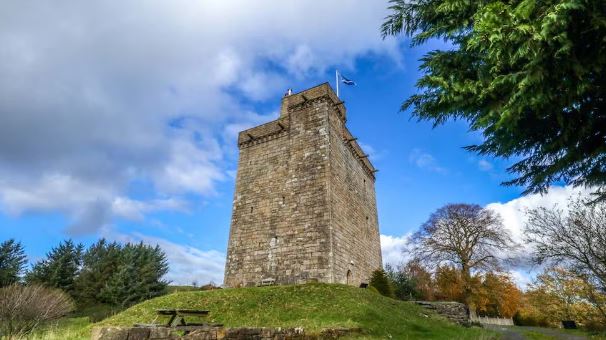
Mains Castle East Kilbride.
Another of the most notable of these grand buildings is in that of Torrance House located within the current Calderglen Country Park. Taking the name of the ancient parish of Torrance, which itself is derived from ‘Tor’ an artificial and mysterious mound of earth located a quarter mile from the current building. The parish was once easily identified by the presence of the Old Kirk of Torrance which sadly had fallen into ruin by 1589. Thankfully not the case for the current Torrance house that was built circa 1605 by Roger Hamilton on the site of the previous Torrance Castle, and later sold to James Stuart of Castlemilk in 1650. It is this family, the Stuarts of Torrance who built the mausoleum within the grounds of the previously mentioned East Kilbride Old Parish Church, and remained the eternal resting place of family members until 1801. Between 1948 and 1966 the house was recycled as the headquarters of the East Kilbride Development Corporation. Following a brief period of vacancy and near dereliction in the 1970s ensuing a devastating fire, the house was saved and converted into two private dwellings by East Kilbride district council in 1979, sadly the left wing could not be saved.
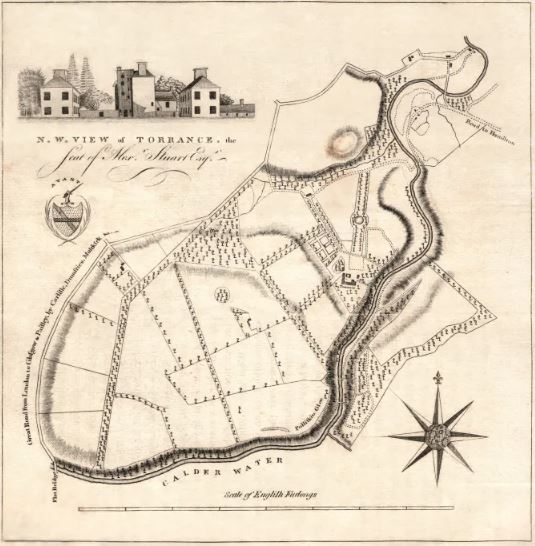
N.W. View, and Map of Torrance East Kilbride (1793).
Likewise within the area of Calderglen Country Park situated on the banks of the Rotten Calder Water stood Calderwood Castle. The castle began life as a ‘Peel Tower’ fortification when it was first constructed. The two main towers were built separately between the 13th and 14th centuries, on the site of an earlier wooden construction. The building stood at roughly 90 feet tall with walls circa 7 feet thick. The footprint of the building measured just short of 70 feet in length and 40 in breadth. The structure was transformed from the robust, practical fortification, towards the more comfortable direction of a manor house with the addition of two new house wings in the mid-18th century. The Castle was once the seat of Baronet Sir William Maxwell from which he operated his business interests from among the tranquillity of the shielded picturesque setting. Disaster struck in 1773, following days of heavy winds and rain, when the original towers collapsed into the gorge, burying the stables situated beneath the castle. Amazingly this calamity led to only one fatality in that of one of the resident hunting dogs. The ruined towers were rebuilt into a new modern style mansion.
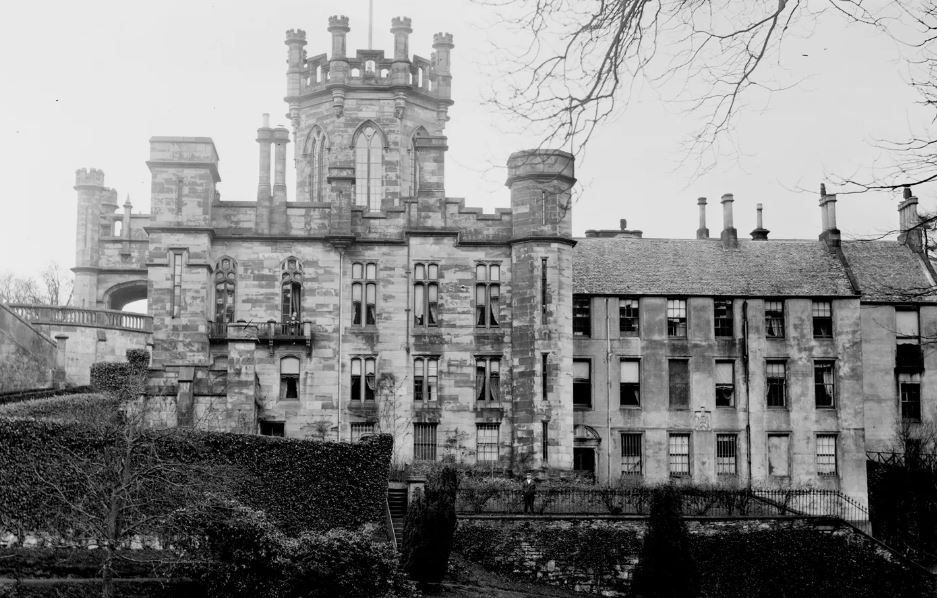
Calderwood Castle, East Kilbride.
In 1845 the Maxwell family further developed the castle with the addition of a grand gothic revival extension, which included a centre piece octagonal tower believed to have been designed by David Rhind. In 1904 the estate was purchased by the Scottish Co-operative Wholesale Society (SCWS) initially for the purpose of using the site for agriculture, and later a museum. The building was later adapted to the use of multiple purposes including a residence for Belgian refugees in WW1 and later British army troops in WW2. Sadly in the ensuing years the castle would fall into a state of significant disrepair and was completely demolished by explosives in 1951, just four years after being purchased by the East Kilbride Development Corporation. Little now remains of the site, or indeed that of the nearby Craigneith Castle which was once used for accommodation to the staff servicing Calderwood Castle.
The oldest building in the town dates back to the early 1640s, and still stands just off Avondale Avenue, now known as ‘Rose Mound’. The building was once the home to the famous Scots playwright James Bridie who helped set up the Citizens Theatre, before he moved out the Isle of Bute to enjoy a secluded lifestyle.
Commerce
Historically the village of Kilbride became renowned in the area for its markets. King William III decreed the right to hold a weekly market every Tuesday and indeed annual fairs, after being constituted as a burgh of Barony. This would became critical to the economic prosperity of the town and her inhabitants for many years. So when the plague raged in parts of Glasgow, the town and many of its neighbours would no longer travel to the city. The town instead opted for a temporary market place location on the high ground half a mile down the old road to Glasgow. The area just near the current James Heritage Park retains the name ‘Market-Hill’ to this day. The town would again feature in the national map with its very successful one-day cattle shows, which were the largest in Scotland and operated from 1772 until the late 1940s being held at the ‘Showpark’ grounds, still in use today and home to East Kilbride Thistle the towns junior league football club.
Unlike many other towns in Scotland, there is no evidence to suggest the town operated significant brewery or distillery facilities. Contemporary records suggest only 2 men working as ‘brewers’ within the town in the mid-1700s. The population would certainly become more thirsty in the following years as in December 1840 there were 19 Inns and public-houses within the parish which was ‘unquestionably prejudicial to the morals of the people’ according to the Rev. Henry Moncreiff Minister of the Presbytery of Hamilton, Synod of Glasgow and Ayr.
In 1947 most of the employment in engineering operations, was split between Dickies, who were the prized manufacturer of pumping wind-mills and rick lifters for the agricultural industries, and Mavor and Coulson who produced coal cutting equipment for the mining industry. The majority of the non-local employees of these businesses would travel into the town via train. The first of which arrived in Kilbride in the form of a passenger drawn locomotive on the 1st September 1868.
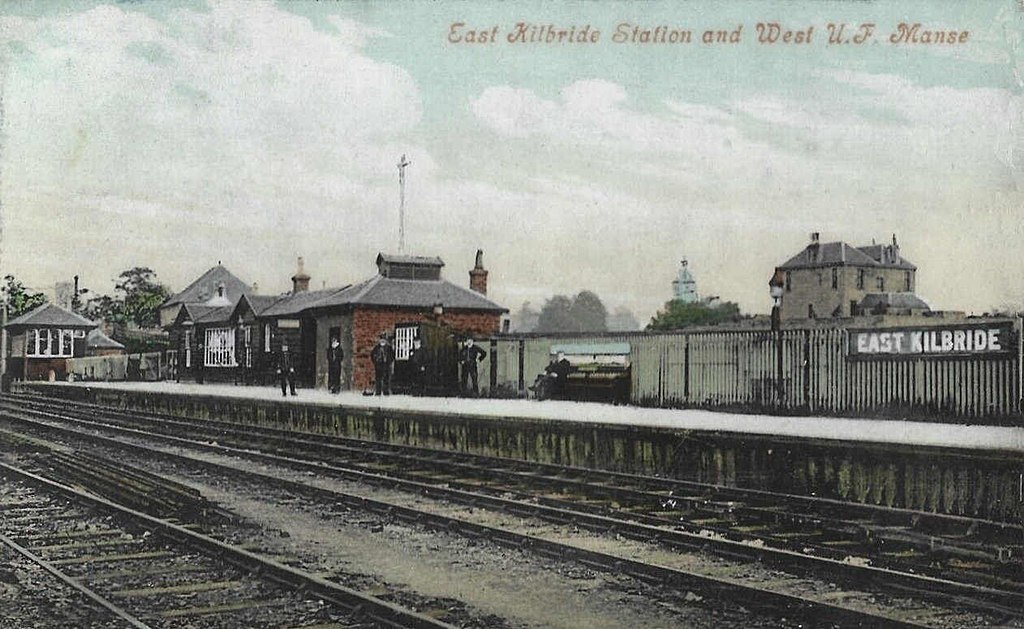
East Kilbride railway station circa 1909 (Postcard).
Kittochside Museum
The current National Museum of Rural Life resides upon part of the estates of Wester Kittochside Farm, which has been owned and operated by the Reid family since the 16th century. The first Laird of Kittochside purchased a portion of the land from Robert Mure, Laird of Caldwell. Mure later attempted to repossess the land and his men attacked the estate on multiple occasions. These attacks culminated between 1597 and 1599, when friends and relatives of Mure, armed with lances, spears, swords, and other ‘fearful wapponis’ threatened John Reid and his family. They eventually managed to seize Reid’s possessions and animals and burned the house down.
In June 1600 the case of Reid vs Mure was brought before the Privy Council in Edinburgh. John Reid protested that Mure had ‘troubled’ him over a period of 18 years. Mure was found guilty and John Reid was declared the rightful owner of Wester Kittochside. Mure was imprisoned in Edinburgh Castle and ordered to repay the cost of the livestock and Reid’s belongings. He was released on condition that he pay part of the debt within eight days of his release and that he no longer harass John Reid.
Throughout the next century the Reid family prospered and increased the land under their ownership. In 1679, two of the grandsons of the first Laird of Kittochside found themselves at the centre of a national conflict. Following the restoration of King Charles II in 1660, many people across Scotland were ardently opposed to his proposal to introduce bishops into the Church of Scotland. An opposition which led to conflict, initially in a field of Drumclog and then at the Battle of Bothwell Bridge nearly six miles from Wester Kittochside. The Royal army was victorious on the day, and actually captured the flag of the Kilbride Parish. One of the grandsons James Reid, was in command of the Kilbryd Company. And when he saw that the flag had been captured took direct action. “Drawing his broadsword he charged through their dumbfounded ranks and, seizing the staff he tore the silk flag from the pole and wrapping it round his body, made his escape amid a hail of bullets.”
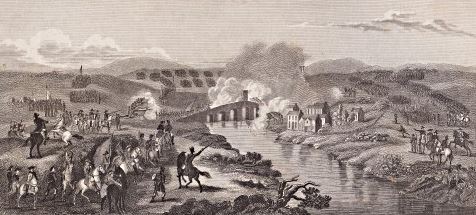
Battle of Bothwell Bridge, 22nd June 1679.
He was taken prisoner and sentenced to a penal transportation. It was only following the intervention of the Duke of Hamilton was his sentence reduced to 6 years in prison, before being released in 1685.
Much of the modern Kittochside estate has its roots in the efforts of the sixth Laird of Kittochside John Reid. Although he inherited the estate at the young age of ten, he was endeared with the modern ideas of farming, including drainage, land division, hedging, and greater consideration of the living conditions for his livestock under the agricultural revolution. John lived to the age of 90 in 1850, and is buried with his wife and five sons within the East Kilbride Churchyard.
The current farmhouse was built by John in 1783 and was funded by an increase in fortunes from ‘improvements’ and from increased demand, and grain prices during the Napoleonic wars.
The First and Second World Wars again saw an increased demand for cultivation in the East Kilbride Parish, in which prisoners of wars contributed to the extra labour demands. This famously included Heinrich Lückel, who was just seventeen when he arrived at Kittochside. He worked from 1946 to 1948, sleeping in the bothy beside the house and ate his meals in the kitchen. Heinrich kept in touch with the Reids long after he returned home to Germany after the war.
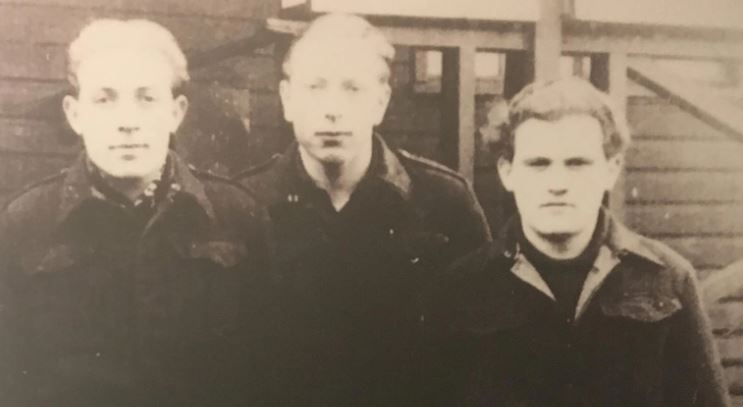
Heinrich Lückel (centre) with two fellow POWs.
At this juncture the farm was mainly operated as a mixture of arable dairy and beef, with modern milking equipment of the time, to support the stock of Ayrshire dairy cows. This all changed in 1963 when the farm changed to fully beef production. The land was used for cattle, and did not opt for the use of large scale farming machines and associated developments, being incorporated at other farms during that period. It is this decision which makes the farm historically special today. The last owners of the estate Margaret and James Reid did not have any children and instead opted to transfer the ownership to the National Trust for Scotland. The farm is now the National Museum of Rural Life since its opening in 2001, and provides a unique glimpse of the day-to-day life of a working farm in the 1950s.
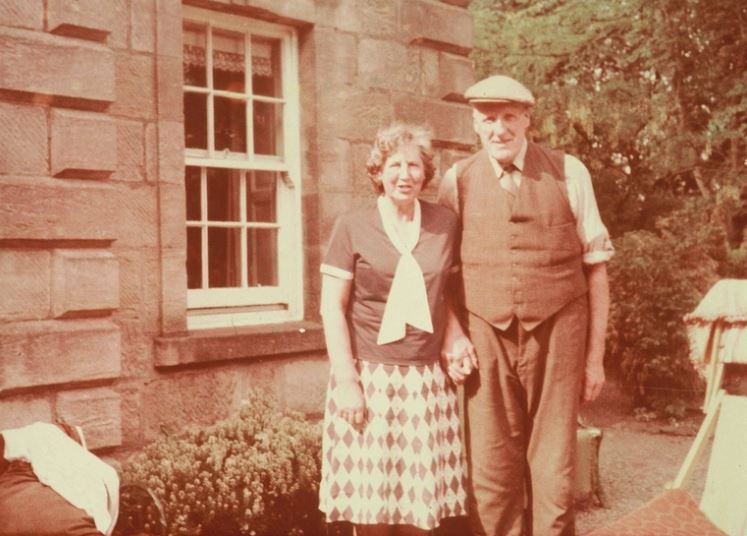
The Reids outside the Wester Kittochside farmhouse.
(Courtesy of National Museums of Scotland)
'Mark One' The New Town
During the reign of William III the small town of Kilbryde was set toward transformation when it was granted the charter of burgh of barony in 1702. This was a significant step in the town’s development as a settlement and transitioning into a more urbanised area. As significant as this change was, it would pale in comparison to the change that would visit the town two and a half centuries later.
In the aftermath of the Second World War the new Labour Government introduced a series of reforms with the intention of improving the health of the population, specifically to target the ‘Five Giants’ of disease, squalor, want, ignorance and idleness under the title of the Welfare State. Part of this included the New Towns Act which successfully passed through the UK Parliament in August 1946. On the 6th May 1947 East Kilbride was officially designated as Scotland’s first new town ‘Mark One’.
It was the vision, that the green fields which surrounded the small peaceful town of East Kilbride would be transformed to a modern thriving town taking the population from circa 2400 to a proposed 82,000 residents. Supported by employment, schools, health facilities, arts, culture, and all the requirements of modern living, to the becoming of one of the UK’s foremost business and commercial centres.
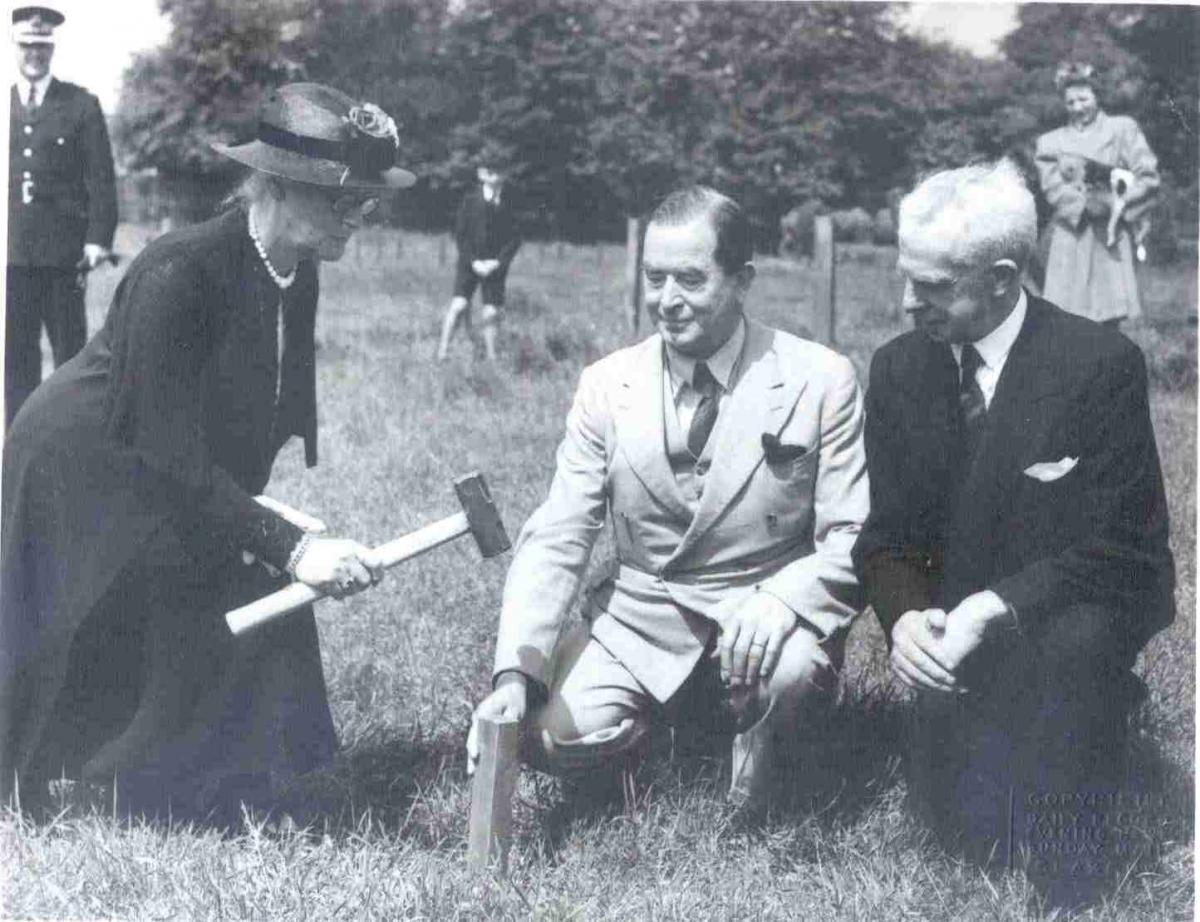
Planner Elizabeth Mitchell, with Arthur Woodburn and Sir Patrick Dollan hammering the first wooden stake of EK in 1947.
The first meeting of the East Kilbride Development Corporation took place on Friday 8th August 1947. In the decade following this meeting the Corporation had directed the construction of 11 factories, 5000 homes, 50 shops, 5 schools, and 7 churches. 1969 saw the 17,000th family move into the town, with the development labelled ‘A Benchmark of urban regeneration’. The Development Corporation was led by chief architects Donald Paterson Reay (1947-52), Francis Clunie Scott (1952-65), Joseph Duncan Beaumont (1965-70), Richard William Colwell (1971-77), Thomas Fraser (1977-83), and James Barrie (1983-94). With the first chairman, Sir Patrick Dollan who would be ‘crucial’ to bringing industry to the new town, and his influence created the long-standing mould and spirit of East Kilbride with his “Dollan’s Dream of East Kilbride”. It has been said that if it had not been for ‘his vehemence in regard the establishment of DSIR (Scottish branch of the Department of Scientific and Industrial Research) in East Kilbride’ the town would never have gone on to achieve its outstanding successes in the backdrop of the 20th century.
A great portion of the corporation’s time would be spent on housing design. Time that would appear to have been well spent, as they would go on to be commended 12 times by the Civic Trust and Saltire Society, in the 1950’s and 1960s. An achievement that should not be underestimated, as the architects of the time were forced to operate within the restrictions of building licences (not relaxed until 1954), and a constant constraint of shortages in both tradesmen and materials throughout. The majority of East Kilbride’s prominent buildings were designed by the foremost architects of the time, including Basil Spence (Duncanrig School), Alan Reiach (Stuart Street/Kirkton Place Housing), Isi Metzstein, Andy MacMillan (St Bride’s Church), Robert Reid (Our Lady of Lourdes R.C Church) and Alexander Buchanan Campbell (Dollan Baths).
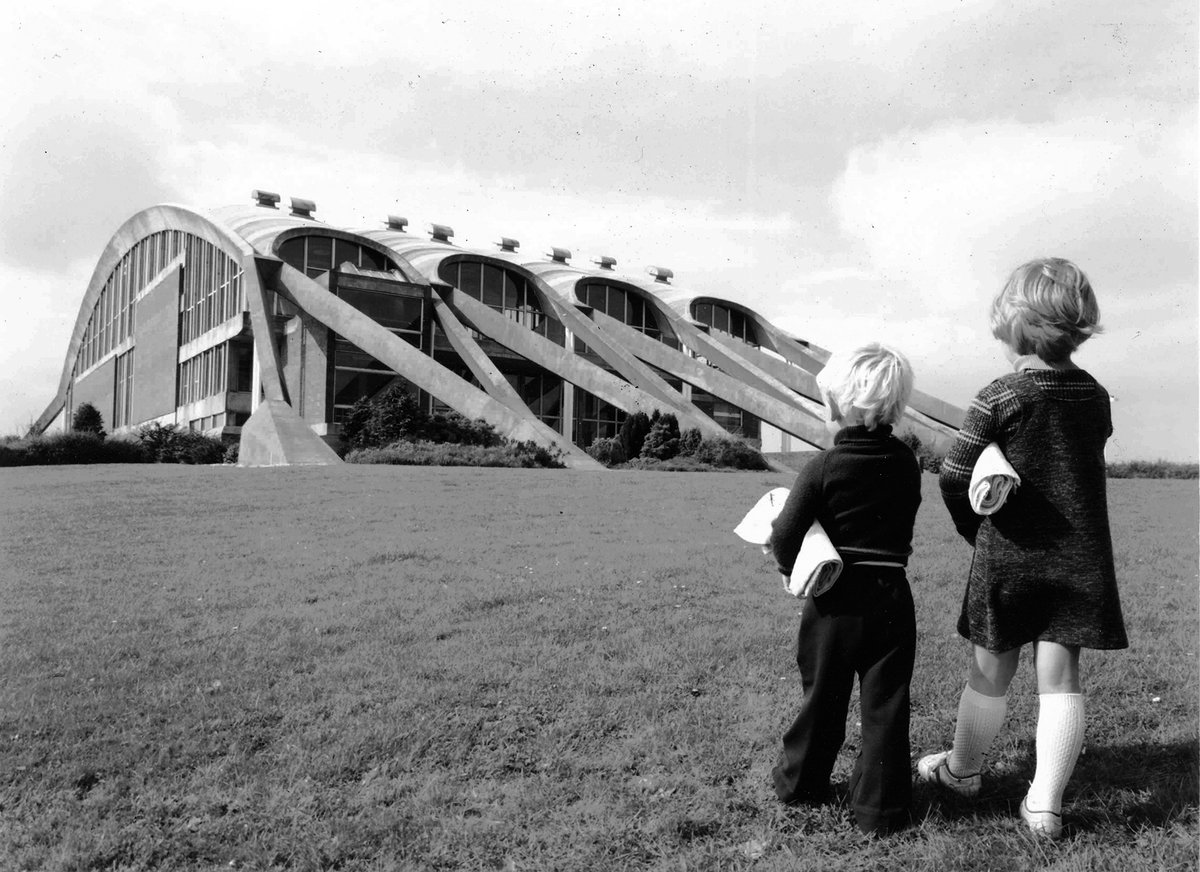
The Dollan Baths 1968.
The town was to be designed as a self-contained community with a carefully planned layout in full contrast of the sprawling chaotic nature of nearby Glasgow. The design incorporated modern, accessible public spaces, footways, bridges, and underpasses, prioritising pedestrian movement. The town was designed to be a cohesive unity, integrating industry, shops, recreation facilities and accommodation within a planned geographic area.
In the latter years of the 1970s a nationwide survey named East Kilbride as ‘Britain’s most successful new town in industrial development’ and boasted impressive figures in all other available categories in the years before and after the survey. At that time 200 businesses were operating from factories within the town, and held the record of being second of all locations across the UK with 17,973 houses being built, as well as 82 commercial offices being created. The East Kilbride Development Corporation wasted no time in adopting the slogan of ‘Britain’s Most Successful New Town’.
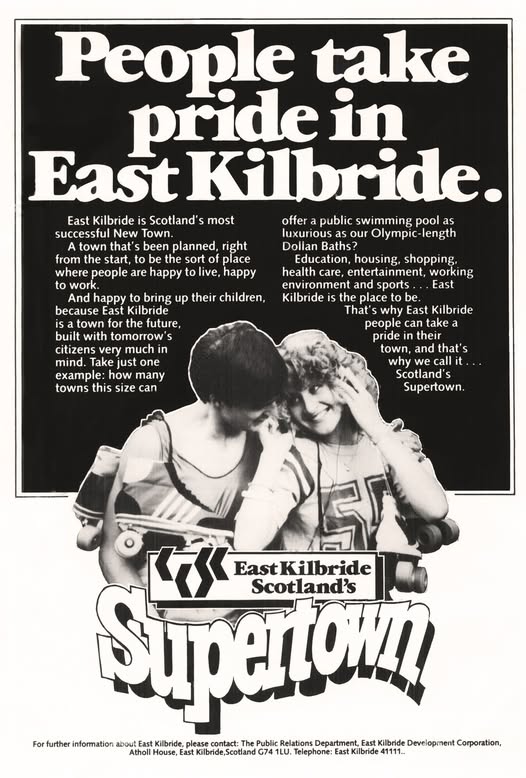
'Supertown' promotion campaign 1984,
Population
East Kilbride is statistically the sixth-largest locality in Scotland with a population of 76,607 according to the census of 2022 with an annual population increase of 0.27% since 2011. And with an area footprint of 25.38km2 suggesting a population density of 3,019 per km2.







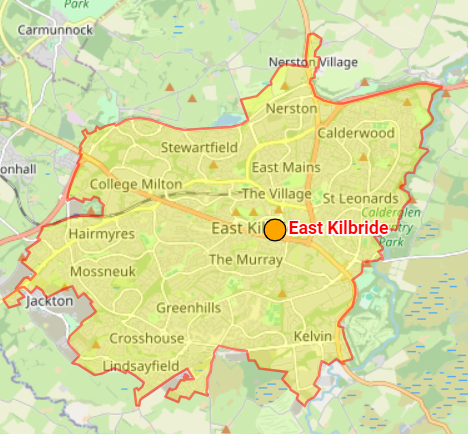
East Kilbride town footprint.
Governance
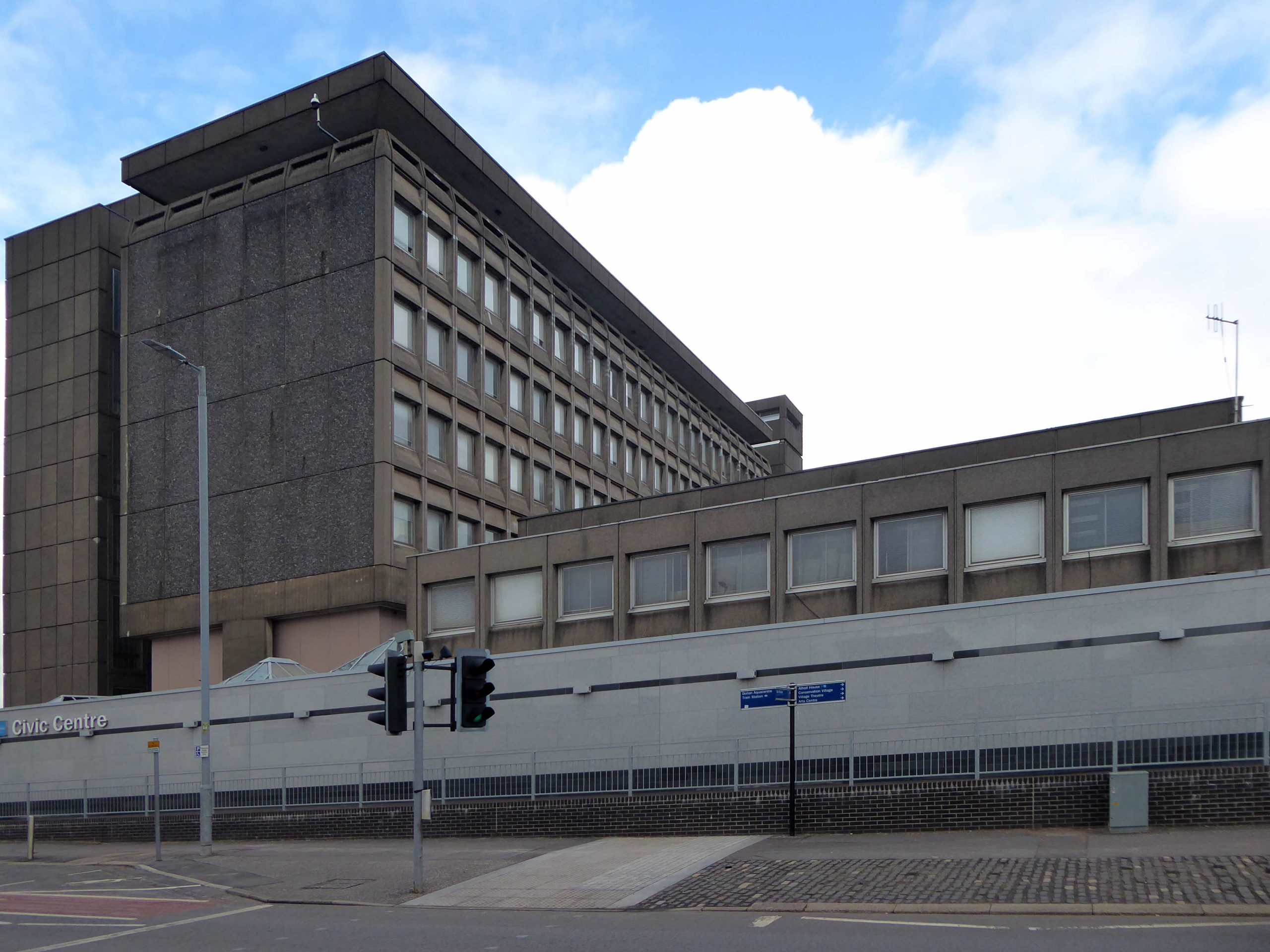
East Kilbride Civic Centre.
In the mid-18th century East Kilbride’s population is estimated to circa 1,500, dropping to over 900, a century later. Despite a gradual increase in the following period, by the turn of the 20th century the population of East Kilbride was still sitting below the 4,000 mark. As such most of the local governance administration was carried out within a ‘handsome sandstone villa’ the village main street known as the ‘Parish Council Chambers building’ of which the construction was completed in 1913. Following a period of dramatic increase of the town’s population ensuing from the new town development, East Kilbride was declared as a ‘small burgh’ in 1963 in line with the Local Government (Scotland) Acts of 1929, and 1930 classification standards. This prompted the burgh leaders to commission new purpose specific buildings at Andrew Street completed in 1968, the same year in which the town would obtain the status of ‘large burgh’.
Following the implementation of the Local Government (Scotland) Act 1973, the town would lend its name to the new District created in 1975. The East Kilbride District was one of nineteen created within the region of Strathclyde, which would abolish much of the former Lanarkshire districts including the East Kilbride Burgh.
The first election of the new East Kilbride District Council was held on the 7th May 1974, and those who were successfully elected worked in a period of shadow-handover with the existing council until full power was handed over on the 16th May 1975.
The election resulted in no overall majority for any party, although the SNP were the largest party winning 7 of the available 15 seats with 36% of the vote share. The same day saw the Labour Party win the Strathclyde Regional Council Election with 71 seats, and 44% of the vote share.
The 1977 District Council Election would see the SNP take control of the council, and would remain in control until 1980. The 1980 election would see the Labour party take hold at East Kilbride, and remain as such until the dissolution of the District Council in 1996.
The YES Town
On the 18th September 2014, the people of Scotland went to the polling stations in their droves all over the country. The debate on the constitution had certainly captured the attention of voters on both sides of the debate seeing a turnout of 84.59% nationwide, and recording the highest turnout for an election or referendum in the United Kingdom since the General Election of January 1910. Which in itself was held before the introduction of universal suffrage. The referendum was the first time that the electoral franchise was extended to include 16 and 17 year olds in Scotland, and was also open to all citizens of the European Union who were residing in Scotland at the time.

Like most other towns and cities across Scotland, many of the local residents of East Kilbride came together to form a local grass roots group to campaign for Scottish Independence. These groups included some members of political parties, but in the most part where made up of residents of the town, who had never been involved in politics previously. With the campaign for No, being driven by the various political parties of the Better Together organisation.
The Yes East Kilbride group became one of the most prominent of the pro-independence campaign groups, with a series of public speaker events, strong online presence, and daily well attended campaign activities throughout the town. By September 2014 every corner of the town was vibrant with debate, and opinion.
The final result saw the No vote win with 55 percent of the vote, with 3.6 million people casting their vote. The official result for East Kilbride posted by South Lanarkshire Council stated that the people of the town voted 54% in favour of No, however this was in fact erroneous. The first point is academic in that the designated East Kilbride voting boundary for the referendum included neighbouring towns and villages which are outside the actual town footprint. But more importantly the SLC official declared results includes a significant caveat stating that the ‘figures can only provide a broad indication of voting outcomes’. This is because the postal votes were handled in such a way that they could not be accurately determined of where they were cast.
The following table provides a partial analysis of the referendum count for East Kilbride, based upon ballot box samples taken at the count, and the official published ‘information on turnout at a local level’ published by South Lanarkshire Council.

These results exclude postal votes, however even if the postal votes from East Kilbride contained a significant lead in votes for No, they would still have not been significant enough to stop the overall result for the town being a victory for Yes.
The publication of this data was made public in the hours following the vote result declaration, and to date has met with universal silence from the groups campaigning for No, thus confirming these findings.
Notable Residents
Bonnie Jeanie Cameron
 One of the most notable and yet locally unrecognised residents of the town, is celebrated in song and verse with a reach stretching across the globe. Although much of her life is lost to history, other aspects are drenched in both the romantic, and in clutches state sponsored character assassination. Even if she were only judged upon her confirmed actions and that of the views of the towns people in her twilight years. Then they would still equate to a selfless hero more worthy of the character captured within myth and legend.
One of the most notable and yet locally unrecognised residents of the town, is celebrated in song and verse with a reach stretching across the globe. Although much of her life is lost to history, other aspects are drenched in both the romantic, and in clutches state sponsored character assassination. Even if she were only judged upon her confirmed actions and that of the views of the towns people in her twilight years. Then they would still equate to a selfless hero more worthy of the character captured within myth and legend.
Jenny Cameron of Glendessary or Bonnie Jeanie Cameron as she is often known, was the daughter of Hugh Cameron of Glendessary and was born in the Knoydart area of the Scottish Highlands around 1698, into a lesser branch of Clan Cameron. Although she was directly related to the Chief of Clan Cameron through her mother. Her immediate family had land in Morven and were well known Jacobite supporters, with her father joining in the 1715 uprising. Although the events of her childhood years are unclear it is suggested that she went to school in Edinburgh, and possibly spent some years in France. It is believed that she later married a distant member of the Cameron Clan, an Irish Officer called O’Neil whom apparently treated her very poorly throughout their relationship. In a very unusual act for the period, Jenny left her marriage and returned to her childhood lands in Morven. In testament to her character she personally ran the family highland estates in the absence of her brothers John and Allan who were travelling abroad for many years.
It was during this time when Jenny received news that Charles Edward Stuart had arrived at Eriskay, and was intending a meeting at Glenfinnan on the banks of Loch Sheil. Jenny being a life-long Jacobite supporter, personally rallied over 300 men, and against the flavours of the time led their march to the gathering at the high ground at Glenfinnan on the 19th August 1745. It was just approaching mid-morning when the prince arrived by small boat at the mouth of Loch Sheil. Greeted in Gaelic by only two shepherds in the vast and picturesque expanse. A short time later the Prince gave welcome to the arrival of 150 MacDonalds. However by 1pm there was still no sign of Chief Donald Cameron of Lochiel who despite initial refusals had agreed to meet the prince on this morning. No one could have known how close the Prince was to despair at this point, with the very rising hanging in the balance, but neither did it matter, because as he would have been staring in wonder at the natural amphitheatre now cradles the ‘Harry Potter Bridge’ his thoughts were interrupted by the distant but recognisable sound of pipes echoing throughout the hills, not just any pipes but those of Clan Cameron. The Cameron’s who would make up two-thirds of the Princes army at this stage, were followed by Keppoch’s men totalling an audience of 1200 men and Jenny Cameron to witness the Prince raising the standard which commenced the 45 rising.
One of the seven men of Moidart Aeneas MacDonald described Jenny as “Among the rest was the famous Miss Jeanie Cameron, as she is commonly, though very improperly called, for she is a widow nearer fifty than forty years of age. She is a genteel, well-looking handsome woman with a pair of pretty eyes and hair as black as jet. She is of a very sprightly genius and is very agreeable in conversation.”
The idea of a female soldier within the Jacobite army was observed a gift to the British Hanoverian, and anti-Jacobite propagandists, who went on full frenzy of character assassination, painting a picture of a ‘hussy’ and ‘mistress’ of the prince, despite her being old enough to be his mother at this point. The attacks on her were so engrained and frenzied that a play was performed at Drury Lane theatre called ‘Harlequin Incendiary or Columbine Cameron’. A reign of character assault that continued in verse and intention for over a century after the events at Culloden.

Her actual life history has been skewed with media falsehoods which ‘took unjust freedoms with her good name’ coupled with the events of other Jenny Cameron’s during that period, including that of the Jenny Cameron an Edinburgh milliner who was arrested in Stirling and imprisoned in Edinburgh Castle in early 1746. She was repeatedly interrogated for 9 months prior to her release. Following which, people would flock to her shop to hear the stories of her ‘adventures with the Prince’ of which she dined on for many years to come – Quite Right!
Jenny was also mixed up as being many other Jenny Camerons of the time with back stories usually steeped in disrepute combined with anti-female tropes still employed today and became more lurid with each retelling. None of which come close to matching the descriptions of the people of East Kilbride who came to know her more than most.
After the 1745 rising, Jenny purchased the Blacklaw mansion and estate a ‘neat and commodious dwelling-house’ in what is now East Kilbride and renamed it Mount Cameron. It is not clear why she chose the Kilbride area, but it is likely as an alternative for the campaign of brutality being carried out across the highlands at this time. She opened a school for orphaned children in the area, having brought with her a number of highland children who had lost their parents during or indeed after the conflict. With many Jacobite’s and highlanders known to pay a visit to her in her new home.
As a devout Catholic Jenny supported the local Presbyterian school, and attended the services of the local Parish church, and despite the propaganda she quickly developed a high standing in the minds and opinions of the people of the town. Not undone by the selfless acts of charity towards locals and poor highlanders alike. With indeed a local minister describing her as “a lady of distinguished family, character and beauty” other descriptions include “informed, intelligent and graceful”. It would appear that for a woman to have possessed the type of spirit and courage to leave a troubled marriage, which many of the time may have likened to a crime, or indeed to raise and lead over 300 men to war, or deal with a lifetime of public persecution, would suggest even more heroic, and compassionate a character in real life than that in myth and legend could ascribe.
Jean would spend the remainder of her life as a ‘highly respected gentry’ in the parish of Kilbride, and was buried near a clump of trees on her lands at Blacklaw in 1773.
Many years later, her grave was disturbed by a tenant of Blacklaw, ‘in the hope of finding gold rings on her fingers’ of which he was disappointed. It would be disturbed in the times to come, as her estate is long gone, and her grave sits among the unrespecting urban grey suburbia of the new town.
The Ten Martyrs
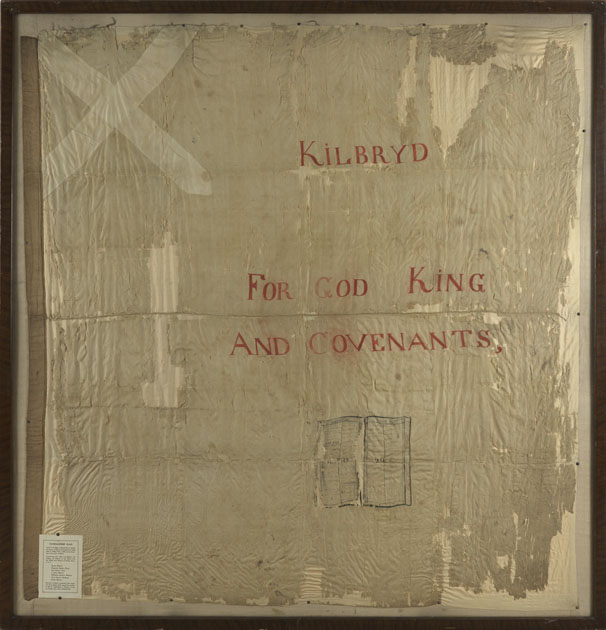
The 'Kilbryd' Standard - From The Battle of Bothwell Bridge 1679.
Sadly, much of Scotland’s history is stained with blood, as is its beautiful green landscapes. East Kilbride has occasionally found itself embroiled within these pages of history. One of the bloodiest chapters occurred in the aftermath of the restoration of the monarchy to Scotland in 1660. A period the author Robert Wodrow labelled as ‘The Killing Time’ in which a bitter feud ensued between the Presbyterian Covenanter movement and the Government during the reigns of King Charles II and James VII, between the years of 1679 to 1688. This period itself being a fallout from another troubled time across the British Isles which can be traced to the agreement of the National Covenant in 1638 in direct opposition of the Laudian Reforms of the Church of Scotland implemented by King Charles I in the 1630s. The signatories of the National Covenant a culmination of a growing movement of those who ‘stood in defence’ of their nations religion otherwise known as the Kirk. Charles saw their actions as a direct act of rebellion against his rule, which ignited the ‘Bishops War’ and the ‘Wars of the Three Kingdoms’. It was the financial impact of these conflicts that prompted the King to summon the ‘Short Parliament’ and the ‘Long Parliament’. This in turn fuelled the Kings dispute with the English Parliamentarians, which itself climaxed in the outbreak of English Civil War in 1645.
The Killing Time oversaw the execution of over 100 people according to the records of the Privy Councils orders. The last of which was the execution of James Renwick in February 1688, an event which historians regard as the end of the period of martyrdom. Although the town’s James Reid of Kittochside was able to avoid execution after his involvement, and indeed recapturing the standard of Kilbryd at the Battle of Bothwell Bridge, many more were not so fortunate. These include:
- John Parker and Christopher Strang who were both hanged and beheaded in Edinburgh in 1666 following their capture at the Battle of Rullion Green.
- John Clyde was hanged in November 1679 with four others at Magus Muir, Strathkinness, following the assassination of Archbishop Sharp.
- Robert Auld, James Clark, John Clark, William Rodger, and John Struthers, were captured by Government forces at the Battle of Bothwell Bridge. Following which they were held for five months in a roofless outdoor prison within Greyfriars Churchyard in Edinburgh, and eventually drowned in a shipwreck off the coast of Orkney on the 10th December 1679 as they were being transported with 200 prisoners to the colonies to be sold as slaves.
- Both John Watt, and Robert Pollock were hanged at Gallowlee on the outskirts of Edinburgh in 1684 and 1685 respectively.
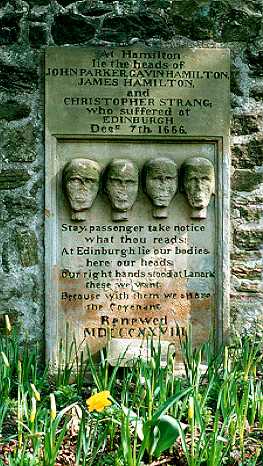
Hamilton Martyrs Monument, Hamilton Parish Churchyard.
Nae Pasaran
Throughout its history the town has been home to, or bore witness to heroic endeavour. As indeed was the case in 1974 when a group of workers from the towns Rolls Royce factory were able to directly impact affairs in taking place in the other side of the world.
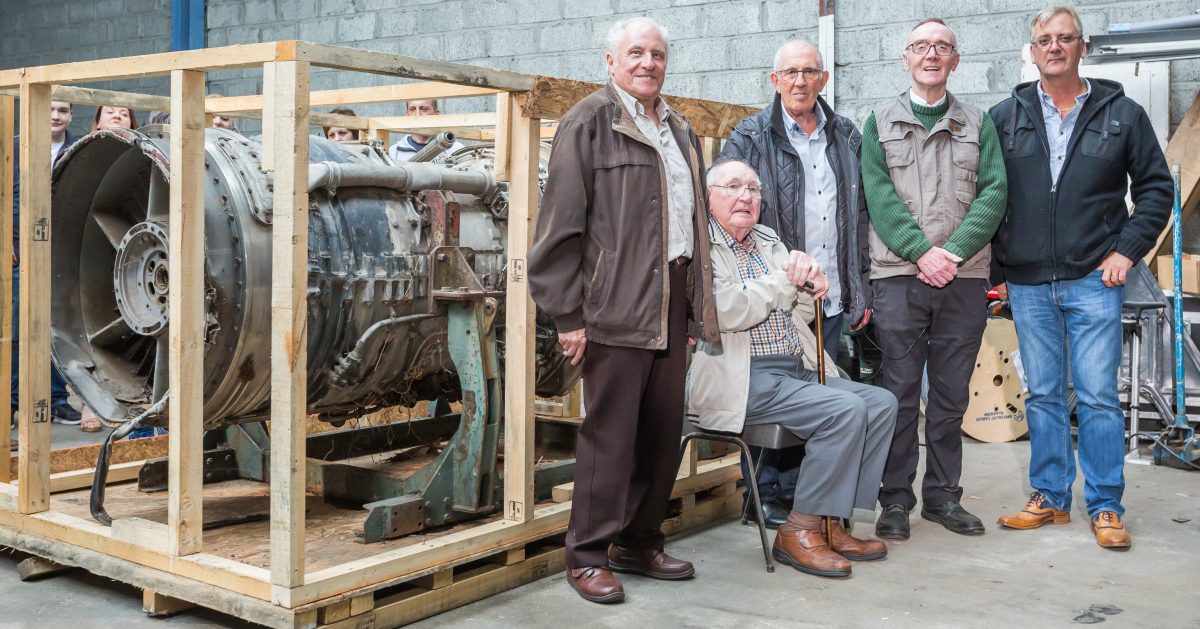
Bob Fulton, John Keenan, Robert Somerville and Stuart Barrie.
With the story later captured by Felipe Bustos Sierra in his 2018 Documentary ‘Nae Pasaran’ in which the four East Kilbride workmates Bob Fulton, John Keenan, Robert Somerville, and Stuart Barrie refused to service and repair engines for the Chilean Air force’s British-made Hawker Hunter jet fighters. The men decided to take this stance following their awareness of the atrocities which were being carried out by the Pinochet dictatorship in Chile between 1974-78, following the country’s bloody military coup in 1973.
After spotting that the arriving engines were labelled as Chilean, Bob Fulton who was an acting shop steward at the time, marked the engines as ‘blacked’ which meant that they were in dispute and could not be worked upon, which made the situation difficult to handle for the factory management team.
The story itself demonstrates how large an impact can result from what may initially appear to be a small intervention. Although they were not aware at the time, the decision of these men at the East Kilbride factory led to a significant reduction in the capability of the Chilean dictatorship’s military air power with critical fighter jet engines rusting in crates, instead of facilitating the dropping of bombs, such as they had done in the earlier part of the coup.
The intervention of these workmates is now recognised as the longest single act of solidarity against Pinochet’s brutal dictatorship.
The four Scotsmen were later awarded the highest honour which the Chilean Government can bestow on foreigners, the Order of Bernardo O’Higgins, at the rank of Commander (Comendador) by Chile’s ambassador to the UK Rolando Drago at the Glasgow City Chambers at a ceremony in 2015.
One of the engines involved in the action, was rediscovered after many years, was returned to Scotland and is now displayed as a public monument in commemoration of the boycott at the South Lanarkshire College in East Kilbride.
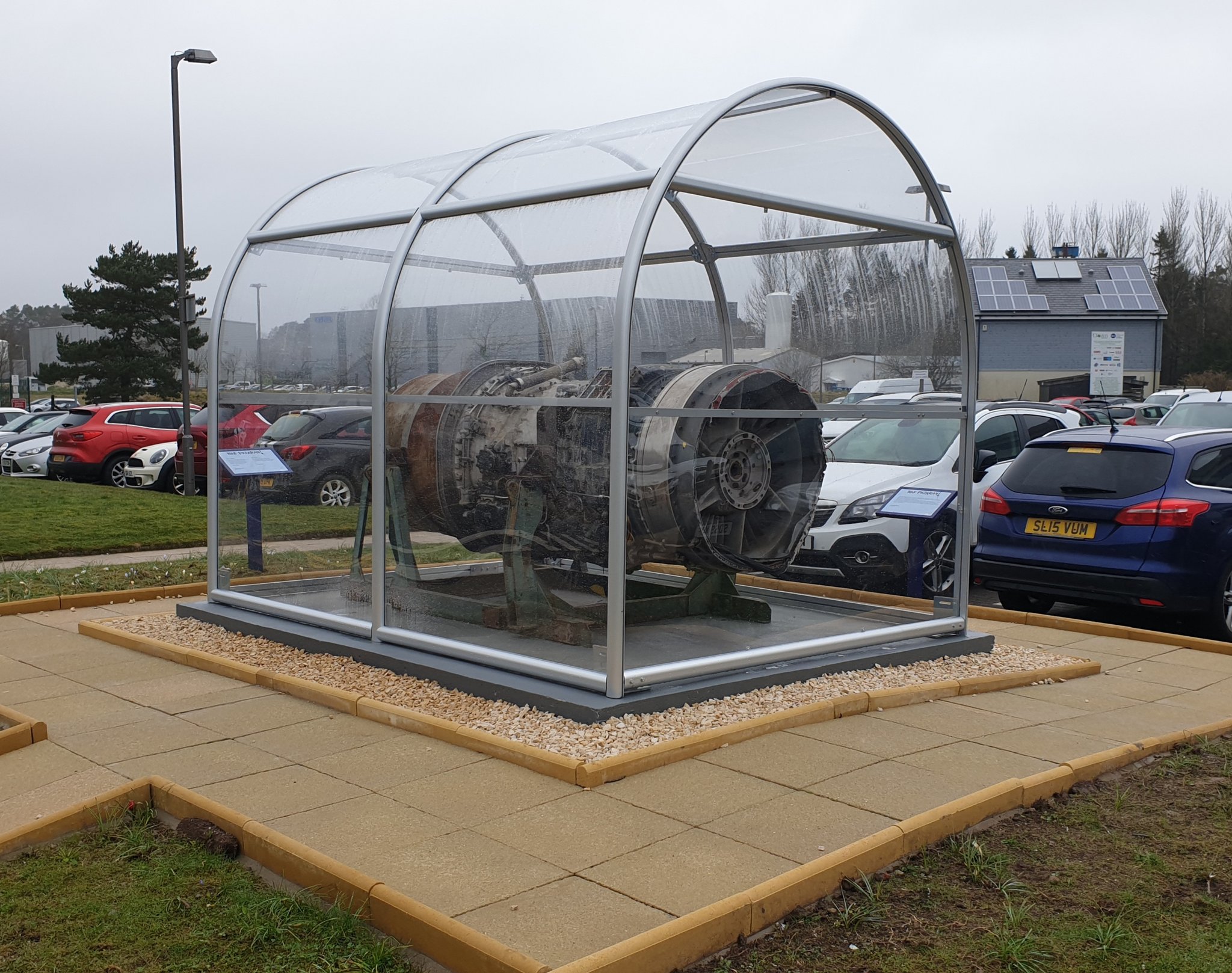
The Engine Monument at South Lanarkshire College.
The documentary won the Best Feature Award at the 2018 British Academy Scotland Awards, it also won the Audience Prize at the San Sebastian Human Rights Film Festival in April 2019.
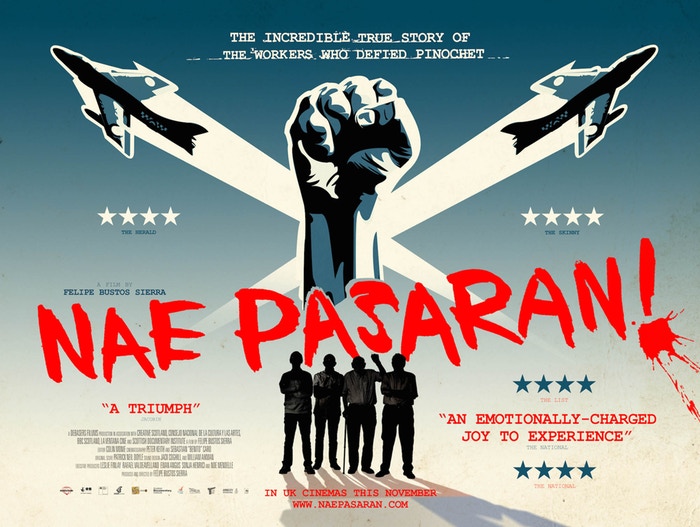
Documentary Promotion Poster.
Famous East Kilbridians
- William and John Hunter
18th-century medical pioneers born at Long Calderwood, now part of East Kilbride; significant contributors to anatomy and surgery.
- John Struthers
Born in a cottage at Long Calderwood, He was a poet, writer, and historian. His Poem ‘The Poor Man’s Sabbath’ remains emblematic of East Kilbride’s literary heritage.
- David Ure
Scottish Presbyterian minister, historian, geologist, and early palaeontologist. Known as ‘The Father of Scottish Palaeontology’.
- Morag Crichton Timbury
Scottish medical virologist, bacteriologist, and science writer. Attended St Brides High School, a leading light in global science. The ‘Timbury Report’ is named after her.
- William Allison
American politician, a republican member of the Wisconsin State Assembly, was born in East Kilbride on the 1st January 1827.
- Robert Findlay Boyd DSO, DFC & Bar
An RAF Ace pilot during the Second World War, A hero of the Battle of Britain, and the Circus Offensive credited with shooting down at least fourteen aircraft during his service, was born in East Kilbride on the 8th June 1916.
- Arthur Connell (Lord Provost)
Born in ‘The Manse’ in East Kilbride, was an 18th century sugar merchant and importer, who served as Lord Provost of Glasgow from 1772 to 1774. He commanded a company of Glasgow Volunteers at the Battle of Falkirk Muir on the 17th January 1746.
- Andrew Graham
A 19th century politician of New Zealand, served as a Member of Parliament from the Gisborne Region, was born in East Kilbride on 28th July 1843.
- Jim and William Reid
The brothers who formed the influential alternative rock band, The Jesus and Mary Chain, both raised in East Kilbride and attended Hunter High School.
- Linda Reid (Sister Vanilla)
Scottish indie rock singer-songwriter, born in East Kilbride in 1971 and younger sister of Jim and William Reid of the Jesus and Mary Chain.
- Denise Mina
Scottish writer, and award winner, referred to as ‘crime writing royalty’ by Val McDermid, and credited with being a key figure in the rise of Tartan Noir. Born in East Kilbride in 1966.
- David R. Ross
The ‘Biker Historian’ A very accomplished Scottish author, and historian with a multitude of TV credits to his name. Remembered for his ‘Walk for Wallace’ in 2005 to commemorate the 700th anniversary of Wallace’s capture and murder.
- Fiona Rintoul
Spent her childhood in East Kilbride, a former financial journalist, and editor, a prize winning writer, poet and translator who now lives in the Outer Hebrides.
- Iain Stewart MBE FGS FRSE
Scottish geologist described as ‘geology’s rock star’ Research Chair of Jordan-UK El Hassan bin Talal in Sustainability at the Royal Scientific Society in Jordan. UNESCO chair in Geoscience and Society, and former member of the Scientific Board of UNESCO’s International Geoscience programme. Also a presenter of a number of science based TV shows for the BBC. Born in East Kilbride and attended Mount Cameron Primary and Claremont High Schools.
- Leonard Birnie Strang FRCP
Scottish professor of Paediatric sciences and Secretary of the Paediatric Committee of the Royal College of Physicians. Renowned for leading the study of pulmonary vasculature in the perinatal period, as well as a contributor to the first accounts of harlequinism and catecholamine secretion in neuroblastoma. Born in East Kilbride on the 13th May 1925.
- Lorraine Kelly
Renowned television presenter, brought up in East Kilbride and a former pupil at Claremont High School.
- Raymond Burke
Scottish playwright, spoken word artist, writer, musician and actor. Joint winner of the Herald McCash Scots Poetry award. Designer of the Metaphoric Table, a literary teaching instrument used by students all over the world.
- Kirsty Young
Scottish television and radio presenter, known for shows such as BBC Radio 4’s Desert Island Discs, and crimewatch, was born in East Kilbride on 23rd November 1968.
- Ally McCoist
Former Scotland and Rangers striker, raised in East Kilbride; attended Maxwellton Primary and Hunter High School.
- Roddy Frame
Frontman of Aztec Camera, grew up in East Kilbride and was a pupil at Duncanrig Secondary School.
- Blythe Duff
Scottish actor, best known for her long standing role as ‘Jackie Reid’ in the Taggart television drama series.
- Adam Sinclair
Scottish actor, best known for his role of Jason Jackson in Boyz Unlimited, and Kent Drake in Rizzoli & Isles. Adam was born in East Kilbride on the 18th April 1977.
- John Hannah
Actor known for roles in "Four Weddings and a Funeral" and "The Mummy," born in East Kilbride.
- Scott Rule
Scottish author, writer, and musician, known for his various BBC comedy sketches for TV and radio with The Comedy Unit, born in East Kilbride.
- Margaret McDonald
Scottish writer, known for the ‘Glasgow Boys’ and multiple poetry and prose publications, spent her childhood in East Kilbride.
- Kate Dickie
Actress recognized for roles in "Game of Thrones" and "Prometheus," born in East Kilbride.
- Shona Kinloch
Scottish sculptor based in East Kilbride, known for her public artworks and contributions to the arts community.
- Alan McGee
Co-founder of Creation Records, instrumental in the rise of bands like Oasis; born in East Kilbride.
- Julie Wilson Nimmo
Scottish actress born in East Kilbride in 1972, known for playing Miss Hoolie in the children’s show Balamory, Mrs Sawdust in the show Olga Da Polga, and DC Megan Squire in the comedy show Scot Squad.
- Muriel Gray
Scottish author, broadcaster, and journalist, the first woman to be Rector of the University of Edinburgh, and the first female chair of the board of governors at Glasgow School of Art. Born in East Kilbride on the 30th August 1958.
- Gordon MacDonald
Founding editor of Photoworks magazine, he is known for his photography, and as an artist, writer, curator, press photographer, and educator, born in East Kilbride in 1967.
- James Bridie
Scottish playwright, screenwriter and physician whose real name is Osborne Henry Mavor who lived for a time in the Rose Mound building in East Kilbride.
- George Orwell
English novelist, poet, essayist, journalist, and critic, famed for penning some of the most thought provoking works of the 20th century. ‘He typed in bed in his dressing gown’ as he worked on chapters of 1984, whilst being treated for tuberculosis at Hairmyres hospital in 1947-48.
- Drew Campbell
Scottish writer, and playwright, President of the Scottish PEN. Former town resident renowned for winning a channel 4 competition with his drama ‘EK-OK’ based around East Kilbride.
- Joanna Baillie
Scottish poet and dramatist, was the niece of William and John Hunter, spent her childhood at Long Calderwood, and credited the experience of being of regular and significant influence in her writings.
The Holiday Destination
There are various circumstantial references that suggest that the area of East Kilbride was often favoured as a retreat from as far back as medieval times, possibly resulting from its breath-taking views, its fresh running water supplies, and its clean and (as many can account) it’s very fresh air. The latter being the motivation for the opening of the tuberculosis sanatorium on the 14th June 1919, on the site of the previous Lanarkshire Inebriate Reformatory at the farm of Hairmyres.
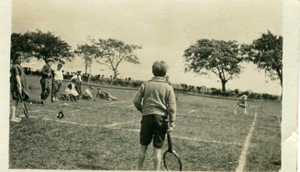
Playing tennis at The Lickprivick Holiday park.
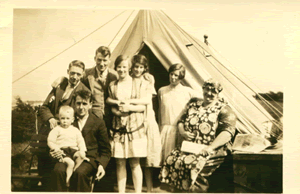
Family in front of their tent.
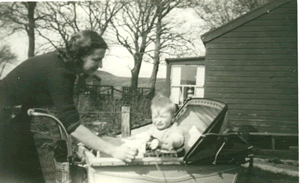
Lady with baby in pram outside the holiday apartments.
But East Kilbride the holiday destination, actually sprung into life in the early 1920’s when the farmers of the Greenhills area of the town would let their lands to eager holiday makers who desired to pitch holiday homes in the area. Over the years the site would see a whole range of different people setup an even wider range of temporary holiday structures such as railway carriages, as the perfect escape with their families from the busy lives in the polluted and hard cities of industrial Scotland.
With a host of differing activities to enjoy ranging from walks around the countryside to tennis tournaments, and enjoying the gardens and livestock, it was surely the Ibiza of its day. The area was a renowned welcome for newly married couples to ‘head up the hill’ and enjoy the getaway of a honeymoon break. A place where many happy memories were cast before the creep of the new town would behold in the 1970s.
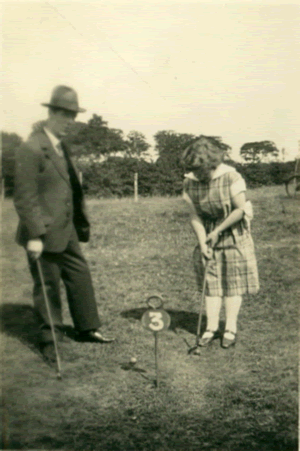
A Couple enjoying some golf at the holiday park.
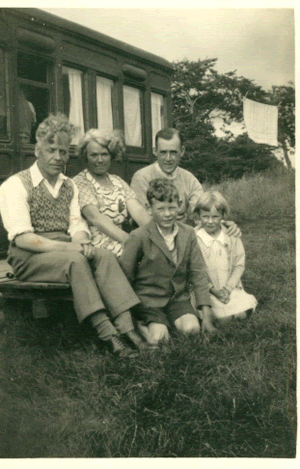
Family outside their train carriage accommodation.
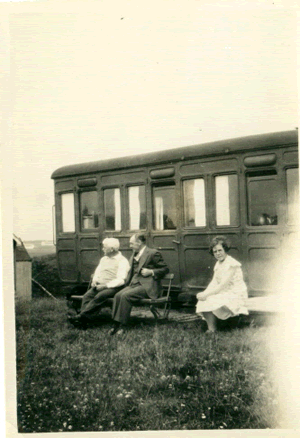
Another family enjoying their stay.
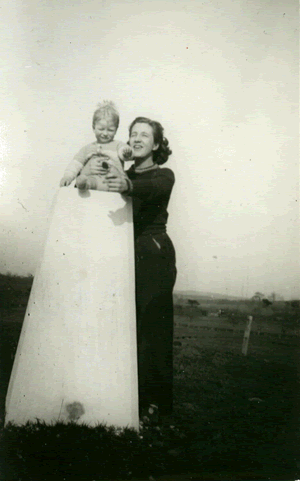
A lady and baby at the holiday park trig-point (High-Point)
These images are a result of the amazing hard work from the Greenhills Millennium Video Group, which we highly recommend checking out by visiting http://gmvg.org

